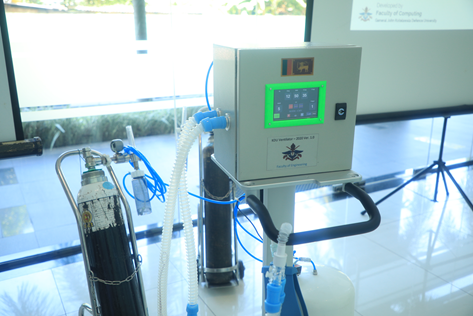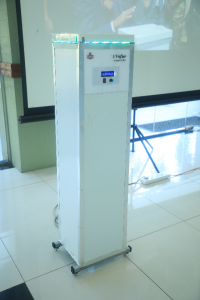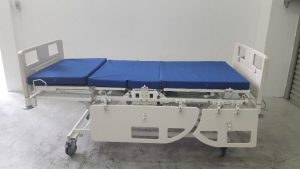
This is a pneumatically driven, time-cycled ventilator with user determined volume and flow rate selection capability. The system is a matched integration of a compressed air tank, air and oxygen inputs, a set of electrically operated valves and tubes, and a patient circuit of tubing. The compressed air tank is pneumatically compressed to supply an air/oxygen mixture. The lung’s elasticity is utilized releasing the overpressure, also called passive exhalation, and expiration is released usually through a one-way valve within the patient circuit tubing. The oxygen percentage of the inspiration supply can be adjusted from 21% (ambient air) to 100% (only oxygen). The prototype design functions on CMV, SMV & Spontaneous modes. The user is facilitated with the touch-sensitive screen to input required and appropriate parameters within each mode of operation such as tidal volume, frequency, Oxygen percentage, inspiration to expiration ratio, system sensitivity. This is an endeavor of a group of research team comprising both academics and students from the Faculty of Engineering in collaboration with the Faculty of Medicine.

This is a development of a medical assistant robot to take care of COVID-19 patients, feed them and to provide them medicine without human direct contact with them. The functions of the prototype includes: ability to deliver food containers & medicine to 8 patients at same bed level by a single cycle, capability to spray sanitizer as per requirement by robotic hand on top of the system, two way communication for doctor and the patient for real time medical inspections, ability to handle the robot remotely and obstacle detection along the way, inbuilt UV sterilization in all dispensers. This product is an outcome of the endeavors of academics and students from Faculty of Engineering, Faculty of Computing and the members of Electronic, Robotic & Innovation Club.
A patient ventilator which is less expensive and takes less time to build using locally sourced materials and components. This ventilator allows the control of all vital parameters during ventilation. It is built to minimize aerosol generation during ventilation. In addition, the machine is built with a self-sterilization mechanism to reduce machine idling time from one patient to the other. This is an effort of a group of researchers from Faculty of Engineering in collaboration with Faculty of Medicine and University of Moratuwa.

‘Curec’ is a mobile app developed by the Faculty of Computing to link the doctors and patients during the COVID-19 Pandemic. It stands for Cure and Recovers. The computer application addresses the problem of over utilizing healthcare resources and minimize the risk of unnecessary exposure of people to the virus. Unlike other prevailing apps, the key features of Curec are the real-time video calling facility and the location tracker. The user is given a self-assessment to identify his/her COVID-19 status based on a scoring system, from High to Low, after which the user can choose to call the doctor. On the other hand, the doctor will answer the call from a priority queue, diagnose the patient, and assign the patient with the medical advice, based on interim guidelines given by the Ministry of Health and Indigenous Medicine for COVID-19 isolation centers. The App also provides a Symptoms Log for the patient to monitor his history and decisions given by previous doctors. The application is developed by a group of academics and students from Faculty of Computing in collaboration with few health professionals.

This purifier is capable of destroying airborne pathogens, such as SARS COV-2 virus, using UV-C light. This device can be used to purify air in a theatre or a ward with patients with respiratory diseases. Since this can be used even when the people are in the room, this is very useful in a hospital setup. This product was developed by a multidisciplinary team of researchers from Faculty of Engineering and University of Sri Jayawardenepura.
A steam inhalation device was designed and produced by Dr. Charith Nanayakkara from the Faculty of Medicine in collaboration with Dankotuwa Porcelain (Pvt) Ltd. The spout of the device has uniquely design that helps inhalation in patients who have nasal congestion, runny nose, ‘sinus’ type headaches, intractable cough and respiratoryrelated issues and therefore considered beneficial for patients infected with SARS-CoV-2. More than 1000 units of the device have already been distributed to a number of hospitals under Ministry of Health, including the IDH, as well as military hospitals, for use during the COVID pandemic.

An Intensive Care Unit Bed developed by students and Lecturers of Department of Mechanical Engineering with lesser cost compared to the present local market which was the cost of Rs 230,000.00. The bed is capable of basis five motions, which is with normal ICU bed and newly introduced lateral bed movement, which enables to transfer a patient from a bed and to bed for the first time in Sri Lanka. This project is developed by group of researchers from the faculty of Engineering.
